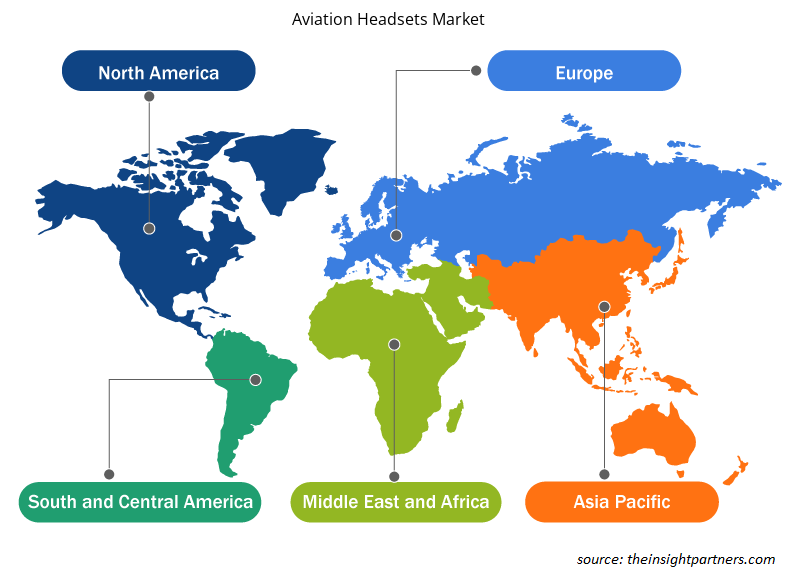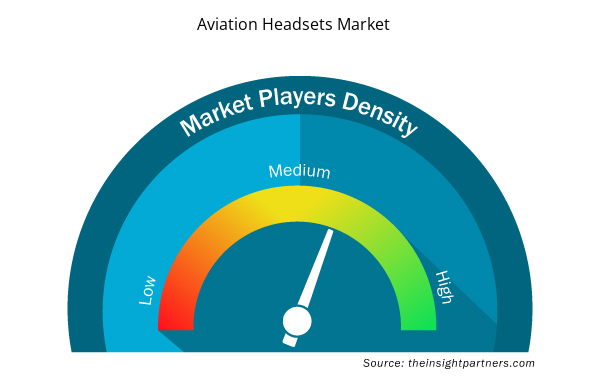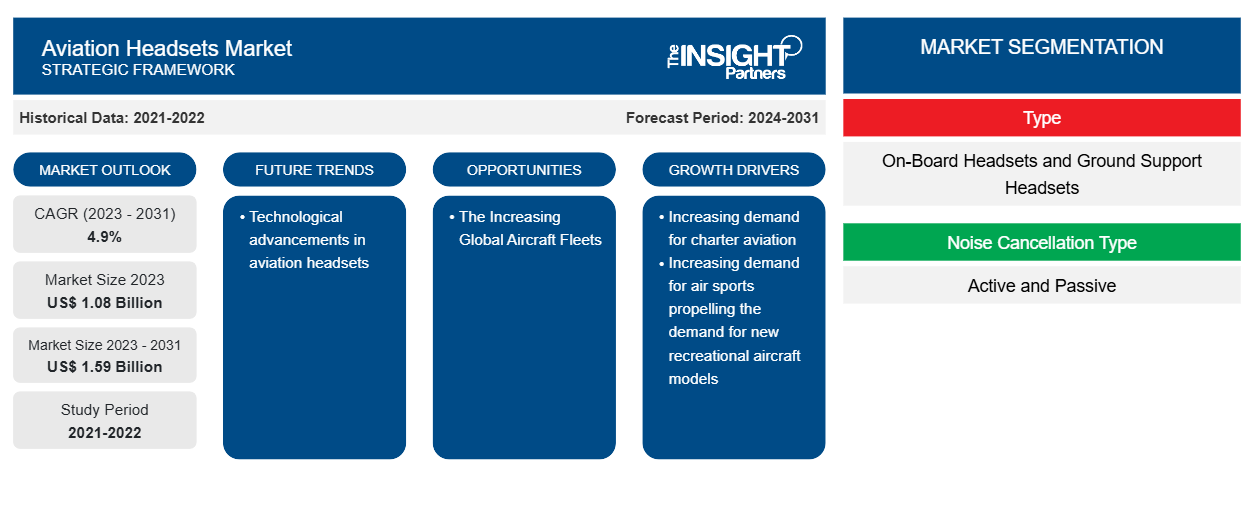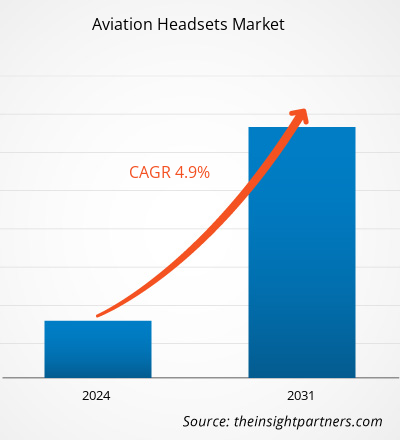Der Markt für Flug-Headsets soll von 1,08 Milliarden US-Dollar im Jahr 2023 auf 1,59 Milliarden US-Dollar im Jahr 2031 anwachsen. Der Markt wird zwischen 2023 und 2031 voraussichtlich eine durchschnittliche jährliche Wachstumsrate von 4,9 % verzeichnen. Der technologische Fortschritt bei Flug-Headsets dürfte ein wichtiger Trend auf dem Markt bleiben.
Marktanalyse für Luftfahrt-Headsets
Das Ökosystem des Marktes für Flugkopfhörer ist vielfältig und entwickelt sich ständig weiter. Seine Interessenvertreter sind Komponentenanbieter, Hersteller von Kopfhörern sowie Händler und Endverbraucher. Wichtige Akteure besetzen die verschiedenen Knotenpunkte des Marktökosystems. Die Komponentenanbieter liefern verschiedene Komponenten wie Halbleiterprodukte/Chipsätze, Mikrofone und Lautsprecherkomponenten an Hersteller von Flugkopfhörern, die diese dann zur Herstellung und Entwicklung der endgültigen Flugkopfhörerprodukte verwenden. Das Endprodukt wird dann über verschiedene Medien, beispielsweise den Direktvertrieb über Unternehmenshändler im gesamten Luftfahrtsektor, an die Endverbraucher vertrieben.
Marktübersicht für Luftfahrt-Headsets
Unternehmen wie Bosch Security & Safety Systems, Bose Corporation, David Clark Company, Lightspeed Aviation, GBH Headsets, Pilot Communications, Plantronics Inc., SEHT Limited und Sennheiser Electronic GmbH & Co. Kg gehören zu den führenden Herstellern auf dem Markt für Flug-Headsets. Diese Unternehmen sind in der Entwicklung, Herstellung und dem Verkauf einer breiten Palette von Flug-Headsets an Endverbraucher wie Fluggesellschaften, MRO-Unternehmen, Luftfahrt-OEMs und Verteidigungskräfte tätig.
Passen Sie diesen Bericht Ihren Anforderungen an
Sie erhalten kostenlos individuelle Anpassungen an jedem Bericht, einschließlich Teilen dieses Berichts oder einer Analyse auf Länderebene, eines Excel-Datenpakets sowie tolle Angebote und Rabatte für Start-ups und Universitäten.
- Holen Sie sich die wichtigsten Markttrends aus diesem Bericht.Dieses KOSTENLOSE Beispiel umfasst eine Datenanalyse von Markttrends bis hin zu Schätzungen und Prognosen.
Treiber und Chancen auf dem Markt für Aviation Headsets
Steigende Nachfrage nach Luftsport treibt die Nachfrage nach neuen Freizeitflugzeugmodellen an
Die steigende Zahl der Auslieferungen von Leichtflugzeugen aufgrund des gestiegenen Bewusstseins für Luftsport bei jungen Menschen fördert die Einführung von Freizeitflugzeugmodellen der neuen Generation. So erzeugt beispielsweise die wachsende Flotte bestehender LSA (Leichtflugzeuge) weltweit eine Nachfrage nach neuen Piloten und Headset-Zubehör. Darüber hinaus wird die Nachfrage nach LSA hauptsächlich durch das steigende Interesse an Freizeitaktivitäten wie Fallschirmspringen angetrieben und ebnet neuen Akteuren den Weg zur Geschäftsgründung, während die bestehenden Akteure ihr Geschäft erweitern, indem sie eine neue Basis errichten und neue Flugzeuge kaufen. Daher fördert die wachsende Flotte von Leichtflugzeugen weltweit die globale Einführung von Flug-Headsets.
Die wachsenden globalen Flugzeugflotten
Der Sekundärforschung von The Insight Partners zufolge umfasste die weltweite Flotte kommerzieller Flugzeuge im Jahr 2022 rund 25.578 Flugzeuge und dürfte bis Ende 2024 auf rund 28.398 Flugzeuge und bis Ende 2034 auf rund 36.413 Flugzeuge anwachsen. Darüber hinaus dürften laut den Prognosen zweier der größten Flugzeughersteller, nämlich Boeing und Airbus, bis Ende 2042 mehr als 40.800 Flugzeuge ausgeliefert werden, was die Nachfrage nach neuen Piloten und Headsets in den kommenden Jahren weiter ankurbeln wird.
Segmentierungsanalyse des Marktberichts für Luftfahrt-Headsets
Wichtige Segmente, die zur Ableitung der Marktanalyse für Luftfahrt-Headsets beigetragen haben, sind Typ, Geräuschunterdrückungsart und Anwendung.
- Je nach Typ ist der Markt für Luftfahrt-Headsets in On-Board-Headsets und Ground-Support-Headsets unterteilt. Das Segment der On-Board-Headsets hatte im Jahr 2023 einen größeren Marktanteil.
- Basierend auf der Art der Geräuschunterdrückung ist der Markt für Flug-Headsets in aktive und passive unterteilt. Das aktive Segment hatte im Jahr 2023 einen größeren Marktanteil.
- Basierend auf der Anwendung ist der Markt für Luftfahrt-Headsets in Verkehrsflugzeuge, Militärflugzeuge und allgemeine Luftfahrt unterteilt. Das kommerzielle Segment hatte im Jahr 2023 einen größeren Marktanteil.
Marktanteilsanalyse für Luftfahrt-Headsets nach Geografie
Der geografische Umfang des Marktberichts für Luftfahrt-Headsets ist hauptsächlich in fünf Regionen unterteilt: Nordamerika, Europa, Asien-Pazifik, Naher Osten und Afrika sowie Südamerika.
Nordamerika dominierte den Markt im Jahr 2023, gefolgt von Europa und dem asiatisch-pazifischen Raum. Darüber hinaus dürfte der asiatisch-pazifische Raum in den kommenden Jahren auch die höchste durchschnittliche jährliche Wachstumsrate verzeichnen. Dies ist hauptsächlich auf die erwartete Auslieferung von mehr als 18.800 neuen Verkehrsflugzeugen in der gesamten Region in den nächsten zwei Jahrzehnten zurückzuführen. Darüber hinaus treibt die steigende Zahl der Flughäfen im asiatisch-pazifischen Raum auch den Einsatz von mehr Flugzeugen in der Region voran, was in den kommenden Jahren voraussichtlich neue Möglichkeiten für Marktanbieter schaffen wird.
Regionale Einblicke in den Markt für Luftfahrt-Headsets
Die regionalen Trends und Faktoren, die den Markt für Flug-Headsets im Prognosezeitraum beeinflussen, wurden von den Analysten von Insight Partners ausführlich erläutert. In diesem Abschnitt werden auch die Marktsegmente und die Geografie für Flug-Headsets in Nordamerika, Europa, im asiatisch-pazifischen Raum, im Nahen Osten und Afrika sowie in Süd- und Mittelamerika erörtert.

- Holen Sie sich die regionalen Daten für den Markt für Luftfahrt-Headsets
Umfang des Marktberichts zu Headsets für die Luftfahrt
| Berichtsattribut | Details |
|---|---|
| Marktgröße im Jahr 2023 | 1,08 Milliarden US-Dollar |
| Marktgröße bis 2031 | 1,59 Milliarden US-Dollar |
| Globale CAGR (2023 - 2031) | 4,9 % |
| Historische Daten | 2021-2022 |
| Prognosezeitraum | 2024–2031 |
| Abgedeckte Segmente | Nach Typ
|
| Abgedeckte Regionen und Länder | Nordamerika
|
| Marktführer und wichtige Unternehmensprofile |
|
Marktteilnehmerdichte: Der Einfluss auf die Geschäftsdynamik
Der Markt für Aviation Headsets wächst rasant, angetrieben durch die steigende Nachfrage der Endnutzer aufgrund von Faktoren wie sich entwickelnden Verbraucherpräferenzen, technologischen Fortschritten und einem größeren Bewusstsein für die Vorteile des Produkts. Mit steigender Nachfrage erweitern Unternehmen ihr Angebot, entwickeln Innovationen, um die Bedürfnisse der Verbraucher zu erfüllen, und nutzen neue Trends, was das Marktwachstum weiter ankurbelt.
Die Marktteilnehmerdichte bezieht sich auf die Verteilung der Firmen oder Unternehmen, die in einem bestimmten Markt oder einer bestimmten Branche tätig sind. Sie gibt an, wie viele Wettbewerber (Marktteilnehmer) in einem bestimmten Marktraum im Verhältnis zu seiner Größe oder seinem gesamten Marktwert präsent sind.
Die wichtigsten auf dem Markt für Luftfahrt-Headsets tätigen Unternehmen sind:
- Bosch Sicherheitssysteme
- Bose Corporation
- David Clark Unternehmen
- Faro Luftfahrt
- GBH Headsets
Haftungsausschluss : Die oben aufgeführten Unternehmen sind nicht in einer bestimmten Reihenfolge aufgeführt.

- Überblick über die wichtigsten Akteure auf dem Markt für Luftfahrt-Headsets
Marktnachrichten und aktuelle Entwicklungen zu Headsets für die Luftfahrt
Der Markt für Flug-Headsets wird durch die Erhebung qualitativer und quantitativer Daten nach Primär- und Sekundärforschung bewertet, die wichtige Unternehmensveröffentlichungen, Verbandsdaten und Datenbanken umfasst. Nachfolgend sind einige der Entwicklungen auf dem Markt für Flug-Headsets aufgeführt:
- Bose, der führende Anbieter von Premium-Headset-Technologie für die Luftfahrt, hat heute seine neueste Innovation vorgestellt: das neue A30 Aviation Headset. Das A30 wurde auf der SUN 'n FUN Aerospace Expo in Lakeland, Florida, vorgestellt und ist ein völlig neues Produkt, das Piloten die beste Kombination aus Komfort, Geräuschunterdrückung und Klangklarheit aller auf dem Markt erhältlichen Aviation Headsets bieten soll. (Quelle: Bose, Pressemitteilung, März 2023)
Lightspeed Aviation hat heute das Lightspeed Delta Zulu vorgestellt – das erste der nächsten Generation von ANR-Headsets. Dieses revolutionäre ANR-Headset für die Luftfahrt bietet eine Reihe neuer Funktionen und läutet eine neue Kategorie von Luftfahrtprodukten ein, die „Safety Wearables“ genannt werden. (Quelle: Lightspeed Aviation, Pressemitteilung, September 2022)
Marktbericht zu Headsets für die Luftfahrt – Umfang und Ergebnisse
Der Bericht „Marktgröße und Prognose für Luftfahrt-Headsets (2021–2031)“ bietet eine detaillierte Analyse des Marktes, die die folgenden Bereiche abdeckt:
- Marktgröße und Prognose für Aviation Headsets auf globaler, regionaler und Länderebene für alle wichtigen Marktsegmente, die im Rahmen des Berichts abgedeckt sind
- Markttrends für Aviation-Headsets sowie Marktdynamik wie Treiber, Einschränkungen und wichtige Chancen
- Detaillierte Porter-Fünf-Kräfte-Analyse
- Marktanalyse für Headsets für die Luftfahrt, die wichtige Markttrends, globale und regionale Rahmenbedingungen, wichtige Akteure, Vorschriften und aktuelle Marktentwicklungen umfasst
- Branchenlandschaft und Wettbewerbsanalyse, die die Marktkonzentration, Heatmap-Analyse, prominente Akteure und aktuelle Entwicklungen für den Markt für Luftfahrt-Headsets umfasst
- Detaillierte Firmenprofile
- Historische Analyse (2 Jahre), Basisjahr, Prognose (7 Jahre) mit CAGR
- PEST- und SWOT-Analyse
- Marktgröße Wert/Volumen – Global, Regional, Land
- Branche und Wettbewerbsumfeld
- Excel-Datensatz



Report Coverage
Revenue forecast, Company Analysis, Industry landscape, Growth factors, and Trends

Segment Covered
This text is related
to segments covered.

Regional Scope
North America, Europe, Asia Pacific, Middle East & Africa, South & Central America

Country Scope
This text is related
to country scope.
Häufig gestellte Fragen
North America region dominated the aviation headsets market in 2023.
Increasing demand for charter aviation and increasing demand for air sports propelling the demand for new recreational aircraft models are some of the factors driving the growth for aviation headsets market.
Technological advancements in aviation headsets in airfield ground lighting solutions is one of the major trends of the market.
Bosch Security and Safety Systems, Bose Corporation, David Clark Company, Faro Aviation, GBH Headsets, Lightspeed Aviation, Pilot Communications, Plantronics Inc, SEHT LIMITED, Sennheiser Electronic GmbH and Co KG, MicroAvionics, Aerotion Aviation, and Radial Avcomm LLC are some of the key players profiled under the report.
The estimated value of the aviation headsets market by 2031 would be around US$ 1.59 billion.
The aviation headsets market is likely to register of 4.9% during 2023-2031.
Trends and growth analysis reports related to Aerospace and Defense : READ MORE..
The Insight Partners performs research in 4 major stages: Data Collection & Secondary Research, Primary Research, Data Analysis and Data Triangulation & Final Review.
- Data Collection and Secondary Research:
As a market research and consulting firm operating from a decade, we have published and advised several client across the globe. First step for any study will start with an assessment of currently available data and insights from existing reports. Further, historical and current market information is collected from Investor Presentations, Annual Reports, SEC Filings, etc., and other information related to company’s performance and market positioning are gathered from Paid Databases (Factiva, Hoovers, and Reuters) and various other publications available in public domain.
Several associations trade associates, technical forums, institutes, societies and organization are accessed to gain technical as well as market related insights through their publications such as research papers, blogs and press releases related to the studies are referred to get cues about the market. Further, white papers, journals, magazines, and other news articles published in last 3 years are scrutinized and analyzed to understand the current market trends.
- Primary Research:
The primarily interview analysis comprise of data obtained from industry participants interview and answers to survey questions gathered by in-house primary team.
For primary research, interviews are conducted with industry experts/CEOs/Marketing Managers/VPs/Subject Matter Experts from both demand and supply side to get a 360-degree view of the market. The primary team conducts several interviews based on the complexity of the markets to understand the various market trends and dynamics which makes research more credible and precise.
A typical research interview fulfils the following functions:
- Provides first-hand information on the market size, market trends, growth trends, competitive landscape, and outlook
- Validates and strengthens in-house secondary research findings
- Develops the analysis team’s expertise and market understanding
Primary research involves email interactions and telephone interviews for each market, category, segment, and sub-segment across geographies. The participants who typically take part in such a process include, but are not limited to:
- Industry participants: VPs, business development managers, market intelligence managers and national sales managers
- Outside experts: Valuation experts, research analysts and key opinion leaders specializing in the electronics and semiconductor industry.
Below is the breakup of our primary respondents by company, designation, and region:

Once we receive the confirmation from primary research sources or primary respondents, we finalize the base year market estimation and forecast the data as per the macroeconomic and microeconomic factors assessed during data collection.
- Data Analysis:
Once data is validated through both secondary as well as primary respondents, we finalize the market estimations by hypothesis formulation and factor analysis at regional and country level.
- Macro-Economic Factor Analysis:
We analyse macroeconomic indicators such the gross domestic product (GDP), increase in the demand for goods and services across industries, technological advancement, regional economic growth, governmental policies, the influence of COVID-19, PEST analysis, and other aspects. This analysis aids in setting benchmarks for various nations/regions and approximating market splits. Additionally, the general trend of the aforementioned components aid in determining the market's development possibilities.
- Country Level Data:
Various factors that are especially aligned to the country are taken into account to determine the market size for a certain area and country, including the presence of vendors, such as headquarters and offices, the country's GDP, demand patterns, and industry growth. To comprehend the market dynamics for the nation, a number of growth variables, inhibitors, application areas, and current market trends are researched. The aforementioned elements aid in determining the country's overall market's growth potential.
- Company Profile:
The “Table of Contents” is formulated by listing and analyzing more than 25 - 30 companies operating in the market ecosystem across geographies. However, we profile only 10 companies as a standard practice in our syndicate reports. These 10 companies comprise leading, emerging, and regional players. Nonetheless, our analysis is not restricted to the 10 listed companies, we also analyze other companies present in the market to develop a holistic view and understand the prevailing trends. The “Company Profiles” section in the report covers key facts, business description, products & services, financial information, SWOT analysis, and key developments. The financial information presented is extracted from the annual reports and official documents of the publicly listed companies. Upon collecting the information for the sections of respective companies, we verify them via various primary sources and then compile the data in respective company profiles. The company level information helps us in deriving the base number as well as in forecasting the market size.
- Developing Base Number:
Aggregation of sales statistics (2020-2022) and macro-economic factor, and other secondary and primary research insights are utilized to arrive at base number and related market shares for 2022. The data gaps are identified in this step and relevant market data is analyzed, collected from paid primary interviews or databases. On finalizing the base year market size, forecasts are developed on the basis of macro-economic, industry and market growth factors and company level analysis.
- Data Triangulation and Final Review:
The market findings and base year market size calculations are validated from supply as well as demand side. Demand side validations are based on macro-economic factor analysis and benchmarks for respective regions and countries. In case of supply side validations, revenues of major companies are estimated (in case not available) based on industry benchmark, approximate number of employees, product portfolio, and primary interviews revenues are gathered. Further revenue from target product/service segment is assessed to avoid overshooting of market statistics. In case of heavy deviations between supply and demand side values, all thes steps are repeated to achieve synchronization.
We follow an iterative model, wherein we share our research findings with Subject Matter Experts (SME’s) and Key Opinion Leaders (KOLs) until consensus view of the market is not formulated – this model negates any drastic deviation in the opinions of experts. Only validated and universally acceptable research findings are quoted in our reports.
We have important check points that we use to validate our research findings – which we call – data triangulation, where we validate the information, we generate from secondary sources with primary interviews and then we re-validate with our internal data bases and Subject matter experts. This comprehensive model enables us to deliver high quality, reliable data in shortest possible time.


 Holen Sie sich ein kostenloses Muster für diesen Bericht
Holen Sie sich ein kostenloses Muster für diesen Bericht